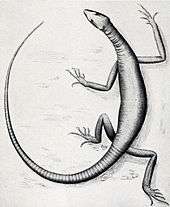Araeoscelis
| Araeoscelis Temporal range: Artinskian, 284.4–275.6 Ma | |
|---|---|
 | |
| Fossil | |
| Scientific classification | |
| Kingdom: | Animalia |
| Phylum: | Chordata |
| Class: | Sauropsida |
| Subclass: | Diapsida |
| Order: | Araeoscelida |
| Family: | Araeoscelidae |
| Genus: | Araeoscelis |
Araeoscelis is an extinct genus of reptile, and one of the earliest diapsids. Fossils have been found in the United States, dating from the early Permian period.

1914 restoration by Samuel Wendell Williston
Araeoscelis was around 60 centimetres (2.0 ft) long, and superficially resembled a modern lizard. It differed from earlier forms, such as Petrolacosaurus, in that its teeth were larger and blunter; possibly they were used for cracking insect carapaces.[1]
Unlike its close relatives, which exhibit the two pairs of skull openings characteristic of diapsids, in Araeoscelis the lower pair of temporal fenestrae were closed with bone, resulting in an euryapsid condition. This would have made the skull more solid, presumably allowing a more powerful bite.[1]
References
- Carroll, Robert L. (1988). Vertebrate Paleontology and Evolution. New York: W.H. Freeman and Co.
- Benton, Michael J. (2000). Vertebrate Paleontology (2nd ed.). Oxford: Blackwell Science.
- Simon and Schuster (1999). The Simon & Schuster Encyclopedia of Dinosaurs and Prehistoric Creatures (1st ed.). Great Britain: Marshall Publishing. ISBN 0-684-86411-8.
This article is issued from Wikipedia - version of the 9/1/2015. The text is available under the Creative Commons Attribution/Share Alike but additional terms may apply for the media files.